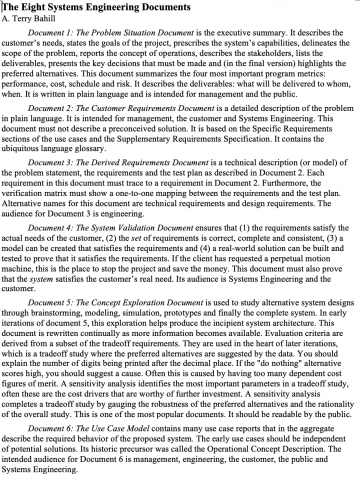Document 1: The Problem Situation Document is the executive summary. It describes the customer’s needs, states the goals of the project, prescribes the system’s capabilities, delineates the scope of the problem, reports the concept of operations, describes the stakeholders, lists the deliverables, presents the key decisions that must be made and (in the final version) highlights the preferred alternatives. This document summarizes the four most important program metrics: performance, cost, schedule and risk. It describes the deliverables: what will be delivered to whom, when. It is written in plain language and is intended for management and the public.
Document 2: The Customer Requirements Document is a detailed description of the problem in plain language. It is intended for management, the customer and Systems Engineering. This document must not describe a preconceived solution. It is based on the Specific Requirements sections of the use cases and the Supplementary Requirements Specification. It contains the ubiquitous language glossary.
Document 3: The Derived Requirements Document is a technical description (or model) of the problem statement, the requirements and the test plan as described in Document 2. Each requirement in this document must trace to a requirement in Document 2. Furthermore, the verification matrix must show a one-to-one mapping between the requirements and the test plan. Alternative names for this document are technical requirements and design requirements. The audience for Document 3 is engineering.
Document 4: The System Validation Document ensures that (1) the requirements satisfy the actual needs of the customer, (2) the set of requirements is correct, complete and consistent, (3) a model can be created that satisfies the requirements and (4) a real-world solution can be built and tested to prove that it satisfies the requirements. If the client has requested a perpetual motion machine, this is the place to stop the project and save the money. This document must also prove that the system satisfies the customer’s real need. Its audience is Systems Engineering and the customer.
Keywords
the eight systems engineering documents
engineering documents
systems engineering
Standards groups
© A. Terry Bahill

